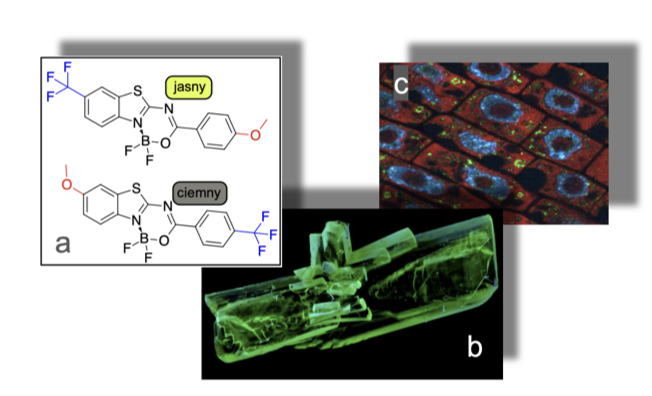Project Leader: Prof. Borys Ośmiałowski
The submitted project focuses on the development of fluorescent dyes intended for bioimaging applications. It encompasses molecular design, organic synthesis, characterization of the obtained compounds, testing in model systems and biological settings, and further structural optimization to achieve the desired photophysical and biological properties.
Description
The research team consists of experts in organic synthesis, photophysical property engineering of dyes, analysis of intermolecular interactions, and cellular and molecular biology, with experience in fluorescence bioimaging. Our goal is to develop a new generation of dyes that enable efficient and selective imaging of structures and monitoring of biological processes. A key objective is to match the photophysical properties of the molecules to the requirements of biological studies, considering emission efficiency and molecular stability in cellular environments.
Unlike conventional approaches that rely on modifying known fluorophores, this project involves the synthesis of entirely new molecular structures. Based on systematic photophysical studies, we plan to design unique molecules with precisely controlled properties. By modifying substituents, ring systems, molecular dipole moments, and non-covalent interaction capabilities, we aim to create dyes “tailored” for specific biological applications. The complexity of the task arises from the numerous parameters that must be considered, including fluorescence quantum yield, absorption and emission wavelengths, selectivity of interactions, the influence of the cellular environment, signal-to-noise ratio, and multiphoton absorption. Optimization of fundamental photophysical properties is itself a complex process.
Equally important are synthetic methods based on organocatalysis (e.g., NHC methods), which allow precise molecular fragment coupling without the use of heavy metals, increasing product purity and safety for biological applications. NHC catalysis also enables the formation of challenging structural connections within emitters. The project carefully considers the impact of intermolecular interactions, which can significantly affect fluorescence.
By deliberately tailoring photophysical properties, the designed dyes have the potential to substantially enhance spatial and temporal imaging resolution, improve detection sensitivity, and enable more advanced, multiparametric biological analyses. Such tools are indispensable for studies on disease pathogenesis and development, molecular diagnostics, and the design of novel therapies. Moreover, adapting dye structures to specific biological conditions—such as intracellular environments, pH, or the presence of specific proteins or ions—opens the possibility of creating probes with functionality exceeding currently available solutions. Therefore, the project contributes not only to the advancement of fluorescent dye chemistry, organic synthesis, and crystal engineering, but also provides a direct response to the growing needs of modern biology and medicine.

a) Selected fluorescent compounds synthesized by the team.
b) Crystal of a furan derivative emitting light—an example of a compound obtained using NHC catalysis.
c) Application of fluorophores in bioimaging—selective labeling of cellular structures and transmission of the fluorescence signal to a microscope detector.
